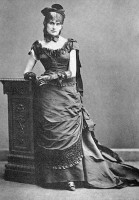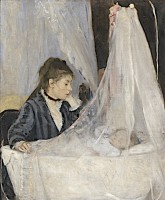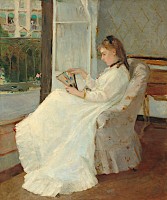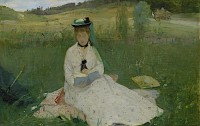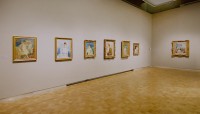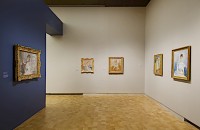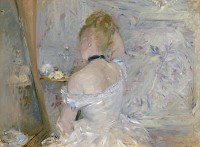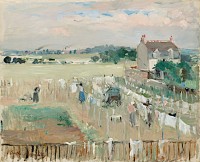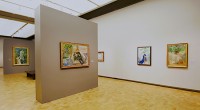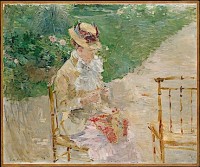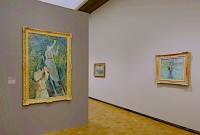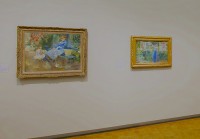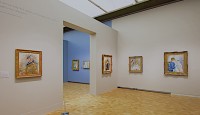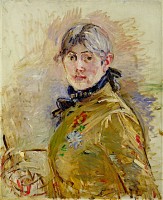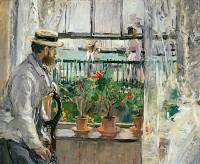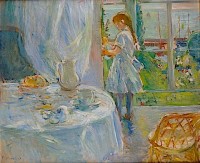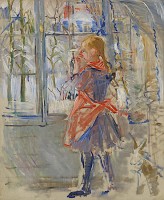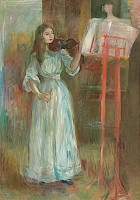The browser will either open the file, download it, or display a dialog.
Musée National des Beaux-Arts du Québec, Québec
June 21–September 23, 2018
Berthe Morisot: Woman Impressionist
The Barnes Foundation, Philadelphia
October 21, 2018–January 14, 2019
Dallas Museum of Art, Dallas
February 24–May 26, 2019
Musée d’Orsay, Paris
June 18–September 22, 2019
Catalogue:
Berthe Morisot: Woman Impressionist.
Edited by Sylvie Patry with essays by Cindy Kang, Marianne Mathieu, Nicole R. Myers, Sylvie Patry and Bill Scott.
New York: Rizzoli Electa, 2018.
247 pp.; 127 color and 10 b&w illus.; chronology; list of Morisot’s exhibitions; exhibition checklist; bibliography; index.
$55.00 (US)
$75.00 (Canada)
ISBN: 978-0-8478-6131-6 (English)
ISBN: 978-2-550-80634-9 (French)
A retrospective of Berthe Morisot’s art is long overdue. The last major exhibition was in 1987 when Mount Holyoke College Art Museum and the National Gallery of Art collaborated on a comprehensive, scholarly examination of her work.[1] In the intervening thirty years, there have been monographic exhibitions on Frédéric Bazille, Gustave Caillebotte, Mary Cassatt, Edgar Degas, Edouard Manet, Claude Monet, Camille Pissarro, Pierre Auguste Renoir and Alfred Sisley, not to mention countless shows on Impressionism in general. There has also been important art historical scholarship on both the role of women artists and on the social, scientific, and economic environments, in which nineteenth-century art evolved. And yet, the stated goal of this exhibition is “the reestablishment of the recognition that Morisot enjoyed in her lifetime; that of a groundbreaking, innovative artist who, against all odds, shaped the trajectory of modern art in France. By shining a spotlight on her artistic achievements, specifically within the realm of painting modern life, we hope to affirm Morisot’s rightful place within the canon of great French artists and assure her legacy for generations to come” (8).
The case for a reevaluation of Morisot’s place in the history of art will be presented to viewers on two continents in three countries; after opening at the Musée National des Beaux-Arts du Québec in June 2018, the exhibition traveled to The Barnes Foundation in Philadelphia where this reviewer saw it, and then to the Dallas Museum of Art and the Musée d’Orsay, Paris (fig. 1). Approximately seventy paintings cover all but Morisot’s earliest work, with an emphasis on her figural images. It was an especially welcome opportunity to see many of the paintings that have remained in private collections since the artist first created them. Organized chronologically within thematic categories, the exhibition explored Morisot’s career from her emergence as a serious painter in the 1860s to her late works in the 1890s. The catalogue follows a similar organization, providing a scholarly apparatus for serious readers as well as a generous selection of color plates and a readily accessible chronology for more casual browsing.
The Barnes Foundation exhibition began with an enlarged formal photograph of Morisot—a Parisienne dressed in an elegant lace-trimmed black dress and wearing elbow length black gloves. In other words, she embodies all that is stylish and appropriate for a young woman from a good family in mid-nineteenth century Paris (figs. 2, 3). This image notwithstanding, the quotation adjacent to the photograph reads: “I don’t think there has ever been a man who treated a woman as an equal, and that’s all I would have asked for—I know I am worth as much as they are.”[2] The quotation, from Morisot’s notebook diary in 1890, offers a plaintive contrast to the image of the young woman captured in the photograph. It also established the overarching theme of the exhibition.
Turning into the first gallery, the painting directly in the line of vision is The Cradle, 1872 (fig. 4). The theme of this gallery, however, was “Becoming an Artist” and that narrative actually began on the wall to the right with a portrait of Morisot by her sister and fellow painter, Edmé. In 1865 when this portrait was painted, both sisters were studying art with Achille François Oudinot, a pupil of Jean-Baptiste-Camille Corot, and were about to exhibit at the annual Paris Salon for the second year in a row. Edmé’s portrait of Berthe shows an intense young woman engrossed in studying the canvas on her easel. The dominant dark brown tones are highlighted only by the artist’s red blouse and the white paint rag clasped in her hand. The influence of Realist painting is evident in both the dark tonality and the subject of a working woman, but within a few years, Morisot herself would shift to a lighter palette and a more open compositional strategy. Her 1869 canvas of Edmé sitting at the window reveals this transformation (fig. 5). In this canvas, the hallmarks of Impressionism are already discernible: a new emphasis on the study of light; the incorporation of Japanese design in both the stylish fan that Edmé contemplates and in the sharply cut-off composition; and the use of increasingly loose brushwork. Morisot is also beginning to explore the contemporary domestic interior as a legitimate subject of modern painting.
In a more personal context, 1869 was the year that Edmé married Adolphe Pontillon, a naval lieutenant stationed at Lorient in Brittany. This was the first time in their lives that Edmé and Berthe were geographically separated by considerable distance. Her sister’s departure also meant that Berthe was the only daughter remaining at home—and unmarried—a fact that was of particular concern to her mother. Nevertheless, the thought of relinquishing her artistic career as her sister did, made Morisot resistant to marriage. When she painted The Cradle three years later, she offered a glimpse of a young mother staring somewhat blankly at her sleeping child, perhaps from exhaustion.[3] This first section of the exhibition thus introduces the visitor to Morisot’s personal challenges as an artist as well as to the family environment, which was simultaneously supportive and problematic.
The following gallery introduces Morisot’s explorations of plein-air painting and the difficulty of capturing the fleeting moment on canvas. Like her colleagues Monet and Renoir, she often focuses on outdoor activity such as harbor scenes or figures in a landscape. Visits to Edmé produced a number of seascapes, both at Lorient and Cherbourg, as well as the painting Reading (fig. 6). Here, the setting is a meadow dotted with wildflowers where a solitary woman sits on the grass reading her book; around her are the objects she brought to this peaceful countryside—an overturned green umbrella, a blanket to sit on, and a Japanese fan. Edmé again served as her sister’s model as she would many times in the coming decades.
The year 1873 was also seminal in Morisot’s career as she started to sell her work on the open market through Paul Durand-Ruel. In general, her work sold well (195).[4] From the outset, Morisot seems to have set clear boundaries about who would make business decisions about her career. Sometime in the fall of 1873, she agreed to participate in an independent exhibition with friends and colleagues who were seeking an alternative to the Salon—in spite of opposition from both Edouard Manet and Pierre Puvis de Chavannes. Morisot showed ten works at the first Impressionist exhibition, held at Nadar’s studio from April 15–May 15, 1874. She was the only woman in the group. It should be noted that Morisot probably met the poet, art critic, educator, and English translator Stéphane Mallarmé at around this time; their lifelong friendship would be a rewarding source of both personal amity and artistic exchange.
The next year was equally momentous for the Morisot family, although for entirely different reasons. Morisot’s father died on January 24, 1874, leaving his youngest daughter bereft and the family without a consistent source of income. As Sylvie Patry, consulting curator at the Barnes Foundation and chief curator/deputy director for curatorial affairs and collections at the Musée d’Orsay, notes in her catalogue essay, “. . . in the absence of a husband, Berthe was now responsible for herself. And so, quite quickly, she started seriously considering marriage” (69). This shift in Morisot’s attitude towards marriage prompted an outcry from her brother Tiburce, who wrote “For the love of God, if you are thinking of getting married, don’t end up with this idiocy and contradiction of a marriage of pure convenience. You could have done that at 18 when your character can be broken and your ideas sapped, but whatever the family tells you, believe me, you can’t [sic] yoke established habits and firm desires and needs at your age to a character unlike yours just to be assured [of] something to live on. And for heaven’s sake, have a little courage!” (69). Morisot and her mother spent the summer with Edmé at the seashore and visiting the Manet family at Fécamp. During these months, Morisot and Eugène Manet painted together often, and eventually announced their engagement; they married in Paris on December 22, 1874. Although the marriage license states that the bride was “without profession,” she not only persevered in her career, but also continued to sign her work with her maiden name (70). As for her brother Tiburce, he was not a fan of his new brother-in-law, but he did concede that “if you love Eugène Manet the slightest bit, then go ahead and marry him fair and square, counting for the future not on him (he’ll never do anything!) but on your own luck” (72). As it turned out, Eugène Manet seems to have been quite content to encourage and support his wife in her work.
Having settled into the apartment previously occupied by Morisot and her mother, the artist continued her work without interruption. The next section of the exhibition addresses the theme of “Fashion, Femininity and la Parisienne” (figs. 7, 8). As demonstrated so ably in the exhibition Impressionism, Fashion, and Modernity (2012–13), fashion played a key role in the development of modernism.[5] Just as the figure of the dandy or flâneur appears in nineteenth-century Paris, so too does the female equivalent, la Parisienne. Art critic and editor of L’Artiste Arsène Houssaye famously wrote that “there are only two ways to be a Parisienne . . . by birth or by dress.”[6] Morisot was both, and like her fellow artists, she was fascinated by the latest designs from the Paris fashion houses as well as the increasing number of printed fashion magazines available to everyone. Throughout the 1870s and 1880s, she often painted images of la Parisienne as a single figure on the canvas. In this gallery, the visitor was introduced to a range of styles from the simplicity of a white muslin gown on a young woman to the haute couture elegance of a dress from the House of Worth.
Woman at Her Toilette, for example, shows a Parisienne seated in front of her mirror as she prepares for an evening out, at the theatre or the opera perhaps. The dress she wears looks very much like the off-the-shoulder design popularized by Worth although it is impossible to pin it down specifically because of Morisot’s handling of the paint (fig. 9). Like the small painting, Hanging the Laundry Out to Dry, on display in the plein-air section of the exhibition, there is an increased ease and fluidity to Morisot’s painting in the mid-1870s (fig. 10). She had already adopted a freely brushed method of painting that abstracts and dissolves the subject in favor of an emphasis on the act of painting itself. Although this canvas is still readily recognizable as a woman at her toilette, it is the beauty of the brushstrokes, the play of light on fabric and glass, and the almost entirely arbitrary use of color that captures the viewer’s attention.
As the visitor moves through this section of the gallery, the solo female figures gradually become images of women bathing or getting out of bed. Nicole R. Myers, curator of European Painting and Sculpture at the Dallas Museum of Art, suggests in her essay “Extreme Novelty or Things of the Past: Morisot and the Modern Woman,” that the artist may have “broadened the scope of her depictions of modern femininity in 1876” because of her “recent success at the public sale she held at the Hôtel Drouot with Monet, Renoir, and Alfred Sisley on March 24, 1875” (87). Eight of the works that she sold there featured Parisian women, and Myers proposes that this may have led Morisot to “break new ground” with canvases depicting boudoir scenes (88). Building on her success with paintings of Parisiennes would have been a sound business decision, although one also has to consider the possibility that Renoir’s or Degas’s images of women bathing or drying their hair may also have influenced Morisot’s choice of subject.
Turning next to the more theoretical—and indeed technical—question of finished versus unfinished canvases, the viewer encounters primarily scenes of the Morisot/Manet family going about their daily activity (fig. 11). There are many paintings of Morisot’s daughter Julie (born November 14, 1878) as well as of Eugène Manet and various nieces, sisters, and cousins. Because most of these paintings remain in private collections, there are few reproductions of them available for publication. Nonetheless, the view of the exhibition in this space shows Julie with her Doll, and a close inspection reveals that her left foot has dissolved into a blur as her mother attempts to capture the restlessness of a young child sitting for a portrait. On the nearby wall is Young Girl with Dog, in which a painting of a slightly older Julie is shown with her back to the viewer and executed with sketchy brushwork that leaves many details to the imagination. These and other similar works in this part of the gallery illustrate Morisot’s experimental explorations of what constitutes an essential element of a painting. How much detail is required to create the essence of a moment? How does an artist capture a sense of movement? Of immediacy? As the decade progressed, it becomes clear that Morisot was gradually eliminating anything that seemed unnecessary or fussy. Like her Impressionist compatriots, she would continuously push the boundaries of the so-called “new painting” throughout her life.[7]
The thematic grouping on the subject of women at work began on the wall opposite the section on finished/unfinished painting. Positioning these two themes parallel to each other on opposite sides of the gallery, however, created confusion as the subject matter shifted inexplicably from one topic to the next. The didactic panel explaining the theme of women at work does not appear until the visitor moves beyond the partition wall dividing the space. That said, this was one of most compelling sections of the exhibition. The sequence of paintings began modestly with the painting of Young Woman Knitting which may be understood as addressing both the question of what is finished or unfinished and the theme of a woman at work (fig. 12). The sketchy quality of the canvas is quite experimental for 1883, as is the flattened, deliberately decorative composition. In addition, there is an ambiguity about the nature of the work being done here. Is this a governess or servant darning an article of clothing or is this a middle-class woman who likes to knit? A similar question might be posed about the large and impressive painting, The Cherry Tree, given pride of place on a free-standing divider in the middle of the gallery space (fig. 13). Are these girls picking cherries from a ladder meant to be understood as farm workers or as the bourgeois children they actually are? The models here were Julie Manet and her cousin Jeannie Gobillard.
The Milk Jug, a small painting hung on the wall perpendicular to The Cherry Tree, began the theme of women (or girls) at work in earnest. This time, the girl struggling to hold up her full milk jug seems to be a genuine farm child. She pauses briefly in the midst of her chores to engage the audience directly, looking at the viewer as if she’s been asked a question. This painting apparently caught Monet’s eye as well when he purchased it at Morisot’s first solo exhibition in 1892 (210). The adjacent canvas was Woman Hanging Laundry, a subject that Morisot returned to often over the years (fig. 14). As Patry remarks in her essay, “. . . the modern woman was a working woman. As such the laundry-women, servants and wet nurses—with their tasks that were of course traditional, but also inseparable in the late nineteenth century from the modern bourgeois lifestyle—were Morisot’s favorite models. These servants were part of her everyday life, but also, as [Linda] Nochlin has shown, reflections of the artist at work” (32–33). Not surprisingly, Morisot’s Self-Portrait is hung in this section side by side with the wet nurse, the governess, and the laundress (fig. 15). Painted at age forty-four, this was the artist’s first self-portrait (fig. 16). In his essay, “A Painter’s Painter” Bill Scott suggests that the impetus for creating a self-portrait at this point in time may have been the artist’s niece Paule Gobillard who hoped to become a painter herself (178). Knowing that the Ecole des Beaux-Arts did not accept female students, she turned to her aunt for guidance, and Morisot responded accordingly. Perhaps she realized that she was already the example that Paule was most likely to emulate, and so decided to paint an image of what it meant to be a woman and an artist under such circumstances. Morisot presents herself in a jacket or smock of some kind covered with bright splotches of paint, and with the same intensely focused gaze that she had when Edmé first painted her portrait at an easel in 1865. She is far from glamorous, but very compelling.
The last two galleries marked a change in Morisot’s career. Painted bright blue rather than the discreet warm grey of the previous spaces, these galleries tackled more abstract and aesthetic themes rather than the descriptive subjects of the earlier sections (see fig. 15). In the gallery devoted to “Windows and Thresholds” the viewer could investigate Morisot’s understanding of spatial organization as experienced in the three-dimensional world and as perceived on the two-dimensional surface of a canvas. In her catalogue essay, “Morisot on the Threshold: Windows, Balconies and Verandas,” the Barnes Foundation associate curator Cindy Kang notes that liminal spaces and thresholds were a motif that the artist experimented with for over two-and-one-half decades (117). In part this was a consequence of industrial innovations in production techniques, such as the increasingly large panels of plate glass that became available for architectural use in the second half of the nineteenth century when large expanses of windows were made possible for residential as well as commercial applications. As a painter of modern life, Morisot was naturally intrigued by the design developments occurring in the world around her. In a painting from her honeymoon trip, In England (Eugène Manet on the Isle of Wight), Morisot positions her new husband at the edge of a large window looking out at a seaside promenade and the harbor beyond (fig. 17). The indoor potted plants on the windowsill merge seamlessly with the garden flowers immediately below the window and lead the eye to the colorful dresses of the passersby. The spatial dimensions of this location remain vague and somewhat flattened, but the sense of moving from the interior to exterior environment is abundantly clear.
A little over a decade later, Morisot’s family returned to the Channel Islands for a summer stay, renting a cottage by the shore (fig. 18). This time, Julie is her model, anchoring the center of the composition, but without a clear definition of the relationship between objects in the room or between indoors and outdoors. The painting is bisected by the vertical line of the curtain’s edge, which at first glance appears to be covering the large expanse of window. Closer inspection undercuts this perception however. The window cannot simultaneously be immediately adjacent to the curtain AND positioned a foot beyond the edge of the cottage floor on the veranda. The figure of Julie stands at the presumed intersection of these two planes, further obscuring a clear understanding of the actual space. It’s evident in this painting and many others that Morisot questioned the accepted conventions of linear perspective more and more confidently over time. By 1886, when she completed Cottage Interior, she was rendering the illusion of three-dimensional space as a purely conjectural structure of two-dimensional reality. In other words, she was employing a Symbolic painterly vocabulary that was less and less connected to the Realism of her youth. In Red Apron, also from 1886, the transition is almost complete (fig. 19). Julie again stands by a window, but both the interior and exterior spaces are almost entirely abstracted.
The final gallery of the exhibition is based on the theme of “A Studio of her Own,” a reference to the fact that, except for a brief period when she was a student, Morisot’s studio was always within her domestic living quarters. While it is true that Morisot painted in her own home, it is not true that she set up her easel in just any available corner while tending to the household responsibilities of an upper middle-class Parisienne. In reality, the custom-built home Morisot and Manet moved into in 1883 was designed around a large, central salon with a full-height ceiling. According to Bill Scott, who photographed the space in 1981, three bedrooms and a dining room on a second level flanked the salon on two sides. It was this large salon space that served as Morisot’s primary studio as well as a social gathering space for friends and family. In Scott’s words, “An enormous ceiling-high window faced the street; through it shone a south light, regulated by cream-colored blinds. When the blinds were open, the room was filled with shifting and moving shadows, not unlike what she encountered when painting outdoors. High up on the west wall of the studio was a window that opened from Morisot’s bedroom, giving her the unique ability to look down and see how her paintings in progress looked when seen from a huge distance” (160).
The paintings in the last gallery date from the 1890s, and deal almost exclusively with music. There are many canvases of Julie playing the piano, playing the mandolin and playing the violin; and there are two paintings of Lucie Léon at the piano, and one of a Mozart sonata duet for piano and violin. Such a concentration on the creation of music links Morisot with her close friend, Stéphane Mallarmé whose poetry was often based on the sound of the words as much as their meaning. Morisot adds yet another layer to the synesthetic whole by joining visual arts with the arts of music and poetry. With the painting titled Violin (Julie Manet Playing the Violin in a White Dress), Morisot has created a Symbolic image, now only tenuously tethered to tradition and realism (fig. 20). The music stand, which is painted bright red, is as tall as Julie; the middle of her violin bow seems to disappear into the fabric of her dress; her “white dress” referenced in the title is actually a mix of blue and mint green with white highlights; and violin itself has an oddly distorted neck obscured by the significantly over-sized sheet music. The multi-colored, dynamic lines of paint in the background underscore this expressive quality, offering the viewer not a clear definition of space or position, but an expression of an emotional reaction to the music.
Morisot’s death at age fifty-four in 1895 brought her Symbolist experiments to an abrupt halt. The retrospective exhibition of her work, which opened on the first anniversary of her death at the Durand-Ruel gallery, contained over 400 paintings, pastels, watercolors, drawings, and sculptures. The organizers of the exhibition—her old friends Degas, Mallarmé, Monet, and Renoir—had worked for three days on the design of the show; Julie was responsible for labeling the works, a task that would eventually become the foundation for a catalogue of her mother’s work.[8] Over the coming decades, Julie would be the primary advocate and guardian of Morisot’s oeuvre, encouraging scholarship, supporting exhibitions, and maintaining the family archive. Without her efforts, we would know far less about Morisot’s contributions to the emergence and development of modernism (22–25).
The exhibition is well supported by the catalogue of the same title. Although it is not the purpose of this review to discuss the publication in depth, mention must be made of the overall content of the essays. Very briefly then, Sylvie Patry’s essay on “Stimulating Ambiguities” offers a scholarly history of Morisot’s reception during her lifetime as well as the erasure of her art historical presence in the hands of twentieth-century male scholars who saw fit to minimize or dismiss her importance in spite of her documented role as a seminal member of the Impressionist group and her acceptance as a fellow avant-garde artist by her male colleagues. Marianne Mathieu provides a detailed, well documented overview of Morisot’s student years as well as her early career. Nicole R. Myers, in addition to her discussion of la Parisienne in Morisot’s work, includes a lengthy examination of how the artist drew on the rococo tradition of French painting in her work. Cindy Kang explores Morisot’s fascination with spatial ambiguity and the tension between two-dimensional imagery and three-dimensional illusion as well as her evolution into decorative painting in the 1880s. And Bill Scott offers an essay from the perspective of a painter who has also spent considerable time and energy as a Morisot scholar. Finally, it is crucial to acknowledge that this catalogue contains reproductions of many of Morisot’s paintings that are rarely seen in public. It belongs on your bookshelf.
Berthe Morisot: Woman Impressionist succeeds admirably in making its case for a reevaluation of the artist’s work and legacy as one of the key artists in the development of Impressionism and modernism. It also exposes many of the attitudes and assumptions about “women artists” that plagued Morisot’s life, not just in her own time, but throughout the decades since her death in 1895. It is no accident that Sylvie Patry opened her essay with a reference to the Guerrilla Girls in 1989—times have not yet changed enough. Appreciation and study of Morisot’s work has also been hampered by the fact that so much of it remains in private collections unavailable to the public; although this exhibition includes an impressive array of formerly unknown—or at least quite unfamiliar—paintings, the exhibition catalogue will be the only record of their existence in the public forum. That will remain a challenge for scholars to address.
Ultimately, Morisot serves as an example of what a determined and independent-minded woman can achieve. There is much more work to be done in analyzing the interwoven threads of influence among Morisot’s coterie of friends and colleagues; the question of who influenced whom is a task for those with a deep knowledge of Impressionism and without gendered notions about the possible connections. Likewise, there is a rich field of study for anyone intrigued by the links between Mallarmé’s Symbolist poetry and Morisot’s painting. Time to roll up the shirt sleeves and build on what this exhibition has initiated.
Janet Whitmore
Independent Scholar
jwhitmore12[at]gmail.com
The author would like to thank Dierdre Maher, Director of Communications at the Barnes Foundation for her exceptional assistance in assembling materials and images for this review as well as facilitating access to the exhibition.
[1] Charles F. Stuckey, William Scott and Suzanne G. Lindsay, Berthe Morisot, Impressionist, exh. cat. (New York: Hudson Hills Press in association with Mount Holyoke College Art Museum and the National Gallery of Art, 1987).
[2] Berthe Morisot notebook, Mézy, 1890, 34, Musée Marmottan Monet, Paris. Quoted in Marianne Delafond and Caroline Genet-Bondeville, Berthe Morisot ou l’audace raisonné, exh. cat. (Paris: Musée Marmottan Monet 1997), 50.
[3] The model is probably Edmé who had given birth to her daughter Blanche on December 23, 1872. It should also be noted that this painting was very likely part of the exhibition that Paul Durand-Ruel organized in London for the winter of 1873. The painting would have been sent to London in May 1872. See Stuckey, Scott and Lindsay, Berthe Morisot, Impressionist, 54.
[4] One of her earliest sales through Durand-Ruel was View of Paris from the Trocadero, which she consigned to the art dealer on April 28, 1873 for 500 francs; he sold it that same day for 750 francs to the collector Ernest Hoschedé.
[5] See Gloria Groom, Impressionism, Fashion and Modernity, exh. cat. (New Haven, CT, and London: Yale University Press in association with the Art Institute of Chicago, The Metropolitan Museum of Art, New York, and the Musée d’Orsay, Paris, 2012). The exhibition traveled to all three museums over the course of 2012 and 2013. See also the author’s review of this exhibition in Nineteenth-Century Art Worldwide at: http://www.19thc-artworldwide.org/spring14/whitmore-reviews-impressionism-fashion-and-modernity.
[6] Arsène Houssaye, “Quelques opinions avancées sur la Parisienne,” L’Artiste, August 1, 1869, 147. Reprinted in Arsène Houssaye, Les parisiennes: Le Femmes Déchues (Paris: E. Dentu, 1869), 273.
[7] The phrase “new painting” was first used to describe Impressionism by Edmond Duranty in his essay La nouvelle peinture: A propos du groupe d’artistes qui expose dans les galeries Durand-Ruel (Paris, 1876). The phrase was notably used again in 1986 as the title of an exhibition honoring the centenary of the last Impressionist exhibition. See Charles Moffat, The New Painting, Impressionism 1874–1886, exh. cat. (San Francisco: The Fine Arts Museums of San Francisco, 1986).
[8] Stuckey, Scott and Lindsay, Berthe Morisot, Impressionist, 15.




